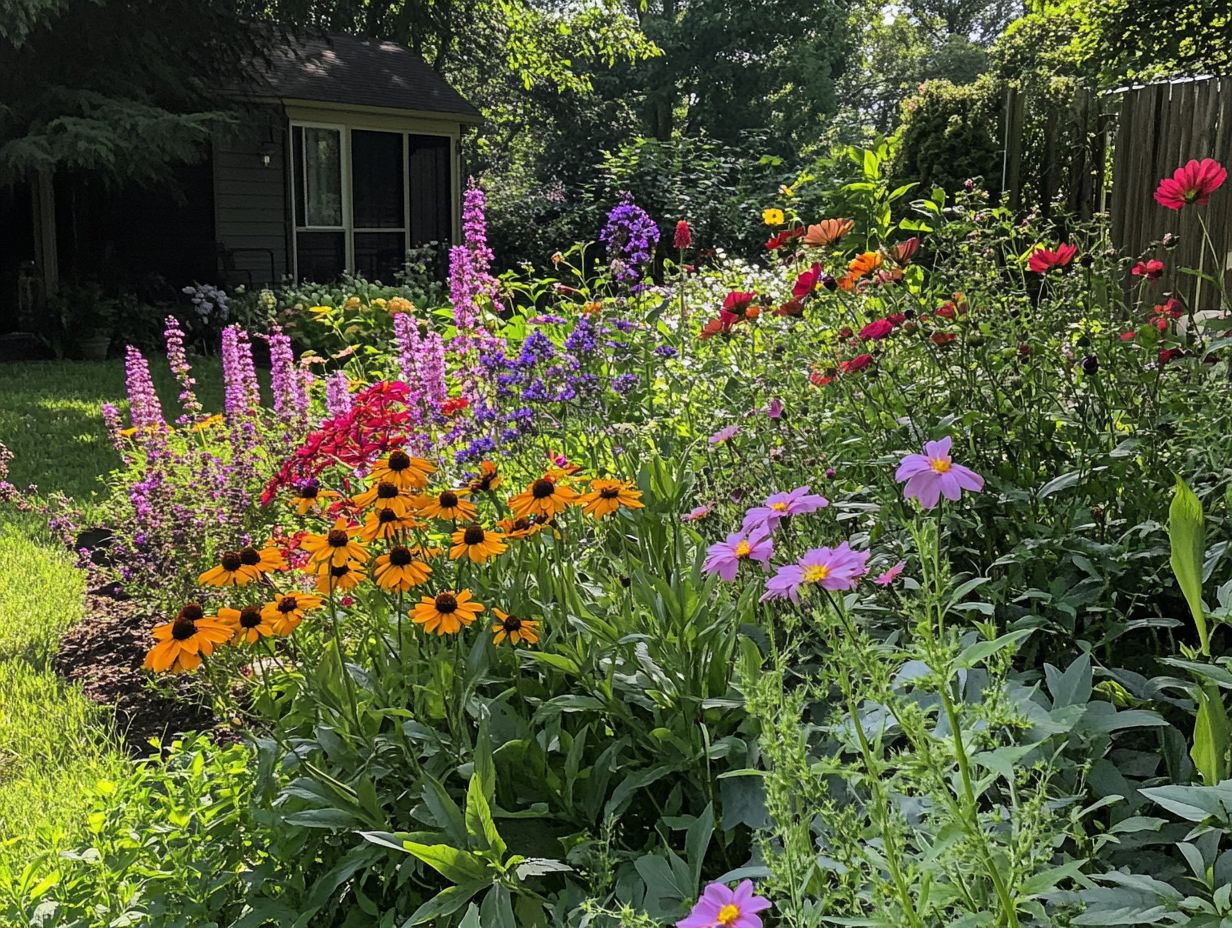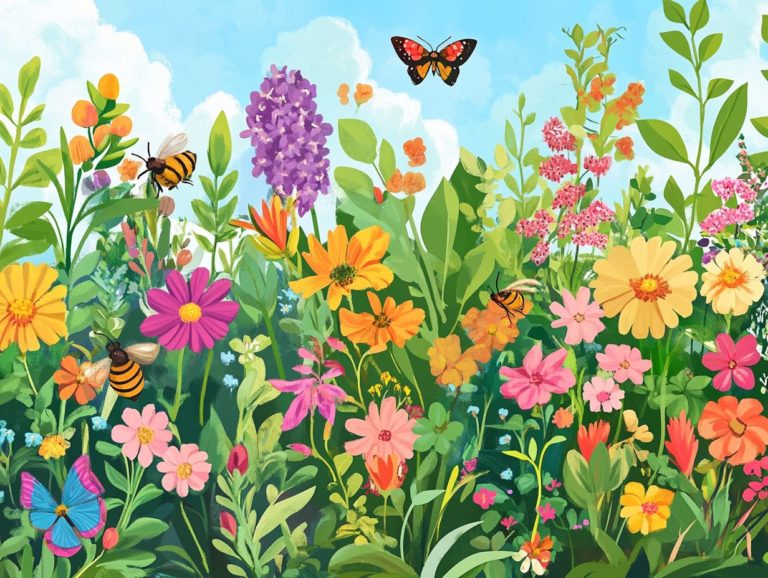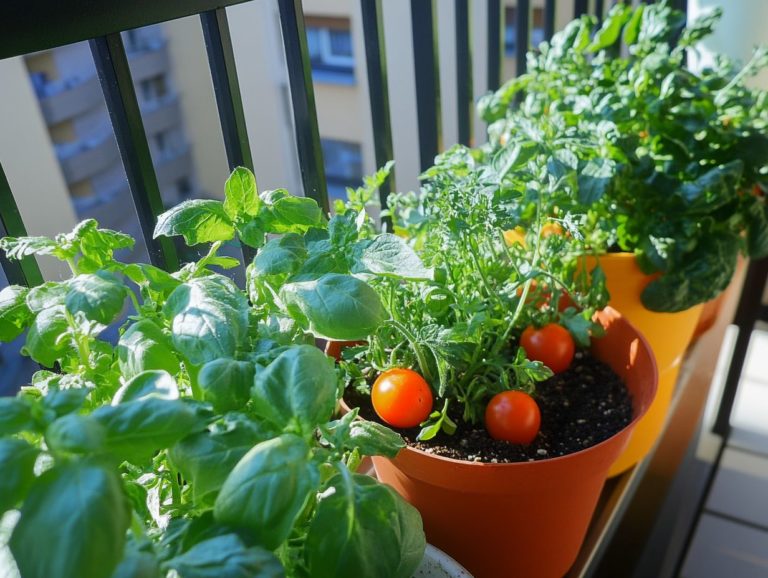“Choosing Plants for Pollinator-Friendly Gardens”
Pollinator-friendly gardens are vital for nurturing our ecosystem and promoting thriving pollinator habitats. As you explore the different types of pollinators and their needs, you’ll uncover the profound importance of these creatures for maintaining healthy gardens.
From choosing the right native plants native versus non-native to crafting a welcoming habitat, this article presents practical tips to cultivate these essential allies. By participating in the effort to foster biodiversity, you can ensure your gardens flourish with vibrant life throughout the year.
Contents
- Key Takeaways:
- The Importance of Pollinator-Friendly Gardens
- Understanding Pollinators and Their Needs
- Choosing Plants for Pollinator-Friendly Gardens
- Tips for Maintaining a Pollinator-Friendly Garden
- Frequently Asked Questions
- What does it mean to choose plants for pollinator-friendly gardens?
- Why is it important to have pollinator-friendly gardens?
- What are some characteristics of pollinator-friendly plants?
- How do I choose plants for different types of pollinators?
- What are some examples of pollinator-friendly plants?
- How can I make my entire garden more pollinator-friendly?
Key Takeaways:

- Pollinators are vital for flourishing gardens because they help plants reproduce and increase biodiversity.
- Different pollinators have specific needs, so choose a diversity of plants that cater to their habitat and food requirements.
- Native plants and flowers that provide food and shelter for pollinators are essential for creating a welcoming environment.
The Importance of Pollinator-Friendly Gardens
Pollinator-friendly gardens are crucial for fostering biodiversity and supporting local wildlife. They offer a haven rich in native plants and nectar sources, which are flowers that provide food for pollinators. These gardens not only make your landscape look beautiful with vibrant flowers but also play a vital role in sustaining pollinator species like bees and butterflies.
By incorporating a variety of blooming plants and ensuring a succession of seasonal blooms throughout the year, you can create lively spaces that provide essential resources for pollinators from early spring to late fall.
Why Pollinators are Essential for Gardens
Pollinators are essential for your garden, playing a crucial role in the reproduction of flowering plants by transferring pollen. This amazing process creates seeds and fruits that feed many species!
Their contributions go beyond pollen transfer; they enhance the overall health and diversity of garden ecosystems. For example, bees are celebrated for their efficiency in pollination, benefiting flowering plants like sunflowers and fruit trees. Butterflies are attracted to nectar-rich flowers such as milkweed and lavender, which provide nourishment while helping maintain a balanced ecosystem.
To boost your garden’s appeal to these essential pollinators, consider the following:
- Choose a variety of flowers that provide food for pollinators.
- Provide shelter and water sources.
- Avoid pesticides to create a welcoming environment for these industrious beings.
Start planting today to make a difference! By taking these steps, you not only enhance your garden’s productivity but also support the intricate web of life that relies on these vital insect pollinators.
Understanding Pollinators and Their Needs
Understanding the diverse array of pollinator species is essential for creating effective habitats that meet their specific needs for food, nesting, and shelter. Common pollinators such as bees, butterflies, and hummingbirds depend on various blooming plants to thrive, each with unique nectar preferences and habitat requirements supporting their life cycles.
This insight allows you to design pollinator gardens that nurture these vital creatures and accommodate their blooming cycles throughout the changing seasons.
Types of Pollinators and Their Habitats
When planning your garden, it s essential to consider the different types of pollinators like bees, butterflies, and hummingbirds. Each of these creatures has unique habitats and requirements. This thoughtfulness promotes ecological balance and enhances the vibrancy of your outdoor space.
For instance, bees flourish in areas rich in flowering plants and need access to clean water. On the other hand, butterflies prefer specific host plants for their larvae, highlighting the critical role of native wildflowers in your garden design. Including wildflowers like milkweed and echinacea not only attracts adult butterflies but also provides the necessary nourishment for their caterpillars.
Hummingbirds, with their preference for tubular-shaped flowers brimming with nectar, add another layer of beauty to your garden. By embracing a variety of native flora, you can create a healthy garden that meets the diverse needs of these essential pollinators, fostering both biodiversity and a lively outdoor atmosphere.
What Pollinators Need from Gardens

Pollinators thrive in gardens designed with their needs in mind. Features like nectar-rich flowers and host plants provide essential food sources and shelter for their survival.
To cultivate a flourishing habitat, diversify your plant selections. Ensure that blooms are available from early spring through late fall. This continual array of flowers not only attracts a variety of pollinators like bees, butterflies, and hummingbirds but also sustains them throughout the seasons.
Choosing specific host plants is vital; certain butterflies will only lay their eggs on particular species. By incorporating native plants well-suited to your local environment, you can significantly enhance your garden’s appeal.
Minimize pesticide use to help create a welcoming oasis. Adhere to gardening maintenance best practices, and provide a water source, such as a shallow dish or birdbath, to support thriving pollinators.
Choosing Plants for Pollinator-Friendly Gardens
Selecting the right plants for a pollinator-friendly garden is essential. Native plants generally provide superior nectar sources and foster a rich diversity of pollinator species.
In contrast, non-native plants often fall short in delivering the same ecological advantages. By prioritizing native flora, you enhance not only the beauty of your garden but also its contribution to the local ecosystem.
Native Plants vs. Non-Native Plants
Native plants generally outshine their non-native counterparts when it comes to supporting local ecosystems, promoting biodiversity, and creating effective pollinator habitats essential for various species’ survival.
These indigenous plants have co-evolved alongside local insects, birds, and other wildlife, forging a symbiotic relationship a relationship where two different species benefit from each other that maintains a balanced ecosystem. Take milkweed, for example; it s crucial for monarch butterflies as the sole host plant for their larvae. In contrast, non-native plants like ornamental grasses often fail to provide the same level of support for local fauna.
Furthermore, native plants are finely tuned to the local climate and soil conditions, requiring less water and fewer resources making them the ideal choice for sustainable gardening. By incorporating a variety of native species into your garden, you significantly enhance pollinator habitats, fostering aesthetic beauty and ecological resilience.
Start your pollinator-friendly garden today! With thoughtful planning and the right plants, you can make a significant impact on local biodiversity.
Flower Shapes and Colors that Attract Pollinators
The shapes and colors of flowers greatly affect which pollinators are attracted to them. Each species is drawn to specific flowering traits during their seasonal blooms.
For example, tubular flowers like honeysuckles easily entice hummingbirds. Their long beaks are perfectly designed to reach the nectar nestled deep within those blooms.
Conversely, flat or open flowers such as daisies are a favorite among bees. They offer straightforward access to both nectar and pollen.
The vibrant colors of flowers also guide pollinators. Bees, for instance, are particularly responsive to blue and yellow shades. This leads them toward blossoms like cornflowers or sunflowers.
When planning a garden, be sure to consider these exciting traits. By selecting a variety of flowers, you can create a diverse habitat that not only captivates the eye but also boosts the odds of effective pollination across different species.
Plants that Provide Food and Shelter for Pollinators
Certain plants do more than just provide food for pollinators; they also offer essential shelter. This creates a balanced environment that supports their life cycles and enhances pollinator care within your garden.
This symbiotic relationship highlights the importance of choosing the right flora. For instance, native flowering plants like milkweed attract butterflies and serve as host plants for their larvae.
Meanwhile, sunflowers provide both nectar and sturdy stems for resting. Herbs such as basil and dill not only enhance your culinary experience but also draw in pollinators, enriching both your garden and your kitchen.
To promote healthy growth and sustainability, make regular watering, mulching, and minimal pesticide use part of your routine. Creating diverse plantings can further enhance this supportive habitat for essential pollinator populations.
Tips for Maintaining a Pollinator-Friendly Garden

To cultivate a pollinator-friendly garden, you need to adopt thoughtful maintenance practices. This includes effective cleanup routines and appropriate watering strategies.
Utilizing sustainable pest control methods that prioritize the well-being of beneficial pollinators is also crucial. By doing so, you create an inviting habitat that nurtures these vital creatures and promotes a thriving garden ecosystem.
Watering and Pest Control Strategies
Implementing effective watering and pest control strategies is crucial for maintaining your plants’ health in a pollinator-friendly garden. These strategies also support vital pollinator species through eco-conscious gardening practices.
To achieve this, consider adopting drip irrigation systems. These systems deliver water directly to plant roots, making them efficient and eco-friendly.
Incorporating mulch is another excellent strategy. It helps retain soil moisture and suppress weeds, creating a welcoming environment for beneficial insects.
For pest control, opt for natural repellents like neem oil or insecticidal soap. These tools effectively target harmful pests without jeopardizing your essential pollinators.
Planting a diverse array of native flowers not only attracts these important insects but also fosters a balanced ecosystem. This reduces the need for synthetic chemicals and promotes a vibrant, sustainable garden.
Start your own pollinator-friendly garden today!
Creating a Year-Round Habitat for Pollinators
Creating a year-round haven for pollinators requires strategic planning for seasonal blooms.
Ensure that garden conditions are ideal for supporting a diverse array of pollinator species throughout the year.
By incorporating a range of plant types think early spring crocuses, vibrant summer sunflowers, and late-season asters you can establish a continuous food source. This not only nurtures a thriving ecosystem but also enhances your chances of attracting various pollinators to your garden.
Managing conditions within your garden is crucial. Emphasizing native plants, maintaining healthy soil, and minimizing pesticide use will significantly boost biodiversity. By setting up small habitats, like brush piles or undisturbed soil areas, you can support pollinators year-round.
Such meticulous planning fosters a vibrant and sustainable garden that benefits both your plants and the pollinator populations that rely on them.
Frequently Asked Questions
Creating a pollinator-friendly garden is not just beneficial; it’s essential!
What does it mean to choose plants for pollinator-friendly gardens?
Choosing plants for pollinator-friendly gardens refers to selecting and cultivating plants that provide food, shelter, and nesting sites for pollinators such as bees, butterflies, and birds. These gardens are designed to support and attract pollinators, which are essential for plant reproduction and the overall health of ecosystems. The inclusion of food sources like nectar sources contributes to their success.
Why is it important to have pollinator-friendly gardens?

Pollinators play a crucial role in our ecosystems by pollinating plants that produce food for humans and other animals. However, their populations are declining due to habitat loss, pesticide use, and other factors. By creating pollinator-friendly gardens, we can provide a safe haven for these creatures and help preserve biodiversity.
What are some characteristics of pollinator-friendly plants?
Pollinator-friendly plants are typically native to the region, have a long blooming period, and provide nectar and pollen as food sources for pollinators. They also have open, shallow flowers that are easy for pollinators to access, and are not treated with pesticides that can harm them. Including a variety of plant species can enhance attractiveness to diverse pollinator species.
How do I choose plants for different types of pollinators?
Different pollinators have different preferences, so it’s important to choose a variety of plants that can accommodate a range of pollinators. For example, bees are attracted to *purple*, *blue*, and *yellow* flowers, while butterflies prefer brightly colored flowers. Hummingbirds are drawn to tubular-shaped flowers, and moths are attracted to white or pale-colored flowers.
Selecting colorful flowers and flowers in bloom will ensure you cater to various pollinator needs.
What are some examples of pollinator-friendly plants?
Pollinator-friendly plants include *coneflowers*, *sunflowers*, *milkweed*, *bee balm*, *lavender*, and *butterfly bush*. Native wildflowers and herbs are also great options, as well as flowering trees and shrubs like *dogwood*, *redbud*, and *serviceberry*.
Incorporating flowering weeds can also provide valuable resources for pollinators.
How can I make my entire garden more pollinator-friendly?
Choose the right plants and provide additional support to make your garden more pollinator-friendly. These include providing a water source, leaving some areas of bare ground for ground-nesting bees, avoiding the use of pesticides, and planting in clusters to attract and support pollinators.
Keep your garden vibrant and diverse to attract more wonderful pollinators! Paying attention to garden upkeep and plant care will ensure a thriving environment.






